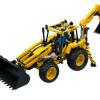-
Content Count
266 -
Joined
-
Last visited
About kolbjha

- Birthday 06/17/1968
Spam Prevention
-
What is favorite LEGO theme? (we need this info to prevent spam)
Technic
Profile Information
-
Gender
Male
-
Location
Trondheim
-
Interests
LEGO Technic
Extra
-
Country
Norway
Recent Profile Visitors
-

Technic 2024 Set Discussion
kolbjha replied to Ngoc Nguyen's topic in LEGO Technic, Mindstorms, Model Team and Scale Modeling
...and for some reason started with 41999! -

[TC26] Technic Arctic Vehicle Contest - Discussion Topic
kolbjha replied to Jim's topic in LEGO Technic, Mindstorms, Model Team and Scale Modeling
What a great contest idea! Nitpicking not intended, but just to get it clear, as the list in brackets may be interptreted as a full list: Is PU and SPIKE elements permitted? Is other 3rd party elements than SBrick (for example BuWizz or PFxBrick) permitted? Other electronics permitted? -

Lets "fix" powered up!
kolbjha replied to allanp's topic in LEGO Technic, Mindstorms, Model Team and Scale Modeling
21335? -

Generic Contest Discussion
kolbjha replied to Jim's topic in LEGO Technic, Mindstorms, Model Team and Scale Modeling
Agree. No need for any size constraints. For me, a small walker with ingenious mechanical solutions would be at least as awesome as a big, complex, Mindstorms based model. However, I would still love to see models from both of these categories, including everything in between. -

Pneumatic pressure switch using current parts
kolbjha replied to ord's topic in LEGO Technic, Mindstorms, Model Team and Scale Modeling
Excellent idea! I also like the idea of @ord, especially since it doesn't need any extra parts. -

Pneumatic pressure switch using current parts
kolbjha replied to ord's topic in LEGO Technic, Mindstorms, Model Team and Scale Modeling
Perhaps use the PU force sensor (45606) combined with a pneumatic cylinder. -

Generic Contest Discussion
kolbjha replied to Jim's topic in LEGO Technic, Mindstorms, Model Team and Scale Modeling
That does not differentiate entries properly. Furthermore, if there are 30 entries and I like 10 of them, why do I have to rank all the other 20 that I don't like. That is pretty difficult. I can not see how distributing up to 3 (or 5) points on individual entries, with a total of X points, would differentiate more. And if you don't want to rank more than say 10 out of 20 entries, then just rank the 10 best of your choice. They would then get 20, 19, ..., 11 points from you, the other entries zero. Then we would not have to worry too much about format giving the votes either, any list of entry numbers would do, comma separated, whitespace separated, one entry on each line etc. would do. And @Jim and @Milan could easily validate each list by removing any duplicate or invalid entry numbers. And if two or more entries should end up with the same total score, differentiate them by finding the highest individual score each of them got, and if that number is the same, then count numbers of that score for each of the entries. If still same score, check the second highest individual score and so on. Relatively easy to make a script for that (for example in Excel). Of course, if you have two entries you consider exactly equal, my suggestion would not give you the opportunity to reflect that in your voting. However, myself, when I have voted in previous competiotions, I have ranked all the entries, and given the points to the top 6 entries accordingly. And some times this ranking has been hard to do, for TC24 I ended up "bubble sorting" the entries; (1) I made an initial list of the entries, (2) then go through the list (3) comparing two at the time (which one of these two do I like best), (3) swapped these two if needed, continue with the same to the bottom of the list, repeat going through the list until no more swapping was necessary. I know this sounds like a lot of work (and it is). I acknowledge that others find it hard to rank, they simply wish to give the score of each entry independant from the other entries. Saying all this, I am just shooting out an idea, I am not even sure if I think this is the best voting system myself. I also like your suggestion a lot, especially the fact that each voter can focus on evaluating each entry independant from the other entries (except that you will still have a limited total number of points to distribute), and the beauty of that there (maybe) is no ranking from each individual voter; the ranking is formed by the community as a whole. -

Generic Contest Discussion
kolbjha replied to Jim's topic in LEGO Technic, Mindstorms, Model Team and Scale Modeling
And another suggestion for public voting : Keep it simple, every voter makes a list ranking all entries from best to least best... Best entry on a voter's list is given points corresponding to number of entries, next is given the same points minus one, etc. For example, if there are 12 entries, the points 12, 11, 10, ..., 1 are distributed from each voter. This will also address one of the main complaints about the currently used formula one system: voters wish they could give points to more than 6 entries. -

42146 - Liebherr LR13000
kolbjha replied to Ngoc Nguyen's topic in LEGO Technic, Mindstorms, Model Team and Scale Modeling
Regarding small leftover parts, I believe their counting machines are highly accurate. I have purchased several hundred sets, and to this day I have never experienced a single missing part, also the leftover parts are the same as in "official" lists (BL etc.), never missing anything. Perhaps somebody have other experience? I think the main reason for these extra parts, as howitzer also mention, is simply to ensure customer satisfacton. The extra parts are the ones most likely being lost during the building process. -

Technic 2024 Set Discussion
kolbjha replied to Ngoc Nguyen's topic in LEGO Technic, Mindstorms, Model Team and Scale Modeling
The space shuttle for example, which is VTOHL. But you are asking "IS", not "WAS", so strictly speaking are you right -

Lets "fix" powered up!
kolbjha replied to allanp's topic in LEGO Technic, Mindstorms, Model Team and Scale Modeling
The reason for my questions was that I want to challenge my own perception that PF for some uses is far better than PU because of its simplicity and physical remote. Of course we still have the issues with non-stackable connectors and missing switch as well, but for now I wanted to simply see for myself if PU can do more or less the same job without spending too much time with configuring and whatnot. I will spend some time testing vascolp's Remote Bla Bla, and after that I will share my experience. I am not so worried by the fact that Pybricks is a 3rd party solution. As far I can see, this solution can be used as long as we can maintain BLE communication with the hubs, regardless of what Lego does or not. -

Lets "fix" powered up!
kolbjha replied to allanp's topic in LEGO Technic, Mindstorms, Model Team and Scale Modeling
Cool! I will try it out and get back. -

Lets "fix" powered up!
kolbjha replied to allanp's topic in LEGO Technic, Mindstorms, Model Team and Scale Modeling
I have been looking a little into Pybricks today, looks very promising. I am trying to achieve the following: Prepare a Technic Hub with a small, standard program in Pybricks to get simple control of 4 motors using two PU remotes. One of the ports (for example B) to be used fixed for a "servo" (for example PU L motor). The other ports for simple power control of 3 motors. I want to use this Technic hub (with its fixed program) + (upto) 2 PU remotes as a replacement for PF Battery Box + (upto) 2 PF receivers + (upto) 2 PF remotes. Simple power on and initialization when I want to use the system, close to what I am used to with PF. Questions: Is this possible? Can I use both L and XL motor for each of the ports without changing the program? Do I need to use all ports or can I connect only the (random) ports I want without changing the program? Of course the "servo" port will be dedicated servo functionality. Can I use only one remote if I for example want to use only one motor + one "servo" without changing the program? -

Lets "fix" powered up!
kolbjha replied to allanp's topic in LEGO Technic, Mindstorms, Model Team and Scale Modeling
I also miss the simplicity of PF. Just to illustrate: A while ago my son and myself found out that we want to play together with the 42030 and 42114. He should use 42030 to load small lego piceces on the 42114 (which I was driving). He turned on the PF BB... and was ready to play. Myself... well, I had to find my cell phone, find and start the app, wait for updates, pairing, etc. and 1-2 minutes later I was ready to play... -

42146 - Liebherr LR13000
kolbjha replied to Ngoc Nguyen's topic in LEGO Technic, Mindstorms, Model Team and Scale Modeling
Regarding Sariel's authenticity rating: He argues quite well that 42146 is not recognizable as any known version of LR13000. Would anybody here identify 42146 as a model of LR13000 with non clues given, other than the picture of the 42146 (without stickers)? How to compare apples and bananas? Of course, 42146 is a crawler crane, and works quite well as that (as Sariel also points out). When TLG claims 42146 is a LR13000 version, it should be to at least some degree recognizable as that. Just a wild example, if 8110 was marketed as an Arocs, how would we rate the authenticity? 8110 is a great model, but clearly not an Arocs. If the reason for Sariel's zero stars is that authenticity, in his opinion, could not be rated, a tip to him could be to put N/A (not applicable) in stead of zero stars, or a footnote explaining zero stars. Just my two cents...




.thumb.png.4f1db645636609c483be10d2626a8e60.png)


